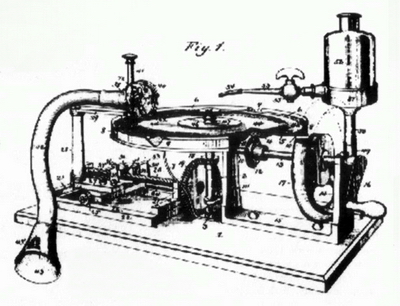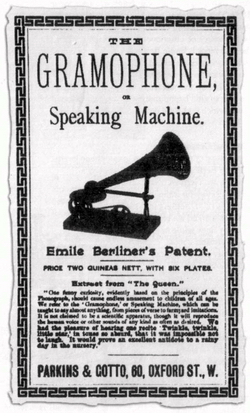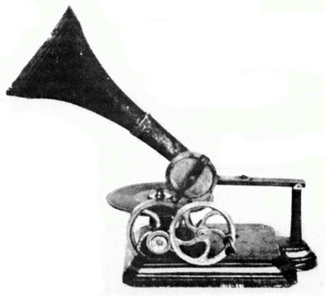|
The History of Berliner Gramophones
Part One
by Mark Caruana-Dingli
The following article, printed in several parts
over the next few issues, will focus on the
contributions made by Emile Berliner who
helped usher in the era of recorded sound. His
move to Canada early in this industry's history is
not well documented, even though his contributions
continued on for many years after leaving the
United States. This will be discussed in detail in
the latter part of this article. I would like to thank
Oliver Berliner (Emile's Grandson and CAPS
member) for his assistance with this article and for
contributing information.
The History of Recorded Sound
Credited with the first successful reproduction of
sound, Thomas Alva Edison was not the first to
propose that a method of reproducing sound was
possible. French inventor Charles Cros had
predicted that after sound waves were etched onto a
glass disk, a copy of the track could be made in a
metal plate and used to recreate the original sounds.
The engraving process was not new, and had been
successfully used in a device called the
Phonautograph built by Leon Scott de Martinville
in 1856. Cros' idea was that sounds could be
reproduced from these etchings. This idea had not
been tested by him as he was unable to obtain the
financial backing needed for his experiments.
At about the same time, Thomas Edison was
conducting his own experiments based on a similar
idea. In 1877 he was successful in impressing the
sound waves into a tinfoil sheet wrapped around a
rotating drum, and is credited with inventing the tin
foil phonograph, a device able to record and
reproduce sound. As Edison's attention was shifted
from this device for a period of time to concentrate
on his electric light bulb experiments, it was left to
others to continue experimenting with this exciting
discovery.
In 1880, Alexander Graham Bell, having just
received the Volta Prize from the French
government, was looking to invest in a new project
and had felt that Edison's tin foil phonograph had
potential. Enlisting his cousin, physicist Chichester
Bell and modelmaker Charles Sumner Tainter,
experiments were conducted leading to many
improvements to the phonograph. Unlike the tin
foil method which resulted in a recording which
could not be replayed more than a few times with
any success, Bell's research yielded a machine
which was capable of a relatively
permanent recording on a wax coated 6 inch long removable
cylinder. To manufacture and distribute this
machine and subsequent models
of it, The American Graphophone Company was founded in
1887. This company, which eventually consolidated
with The Columbia Phonograph Company, was to
be the source of bitter court battles for the father of
the disc record, Emile Berliner. Up to this point the
techniques used to record and reproduce sound
incorporated a groove being etched or indented
vertically into the surface, which was in contrast to
the side to side lateral motion of the etched sound
wave, which had been proposed by Cros and used
by Leon Scott.
Part of Berliner's Canadian Gramophone Patent
No. 55079 from 1895

|
|
The Disc Gramophone
The history of the disc record gramophone begins
with the Berliner Gramophone Company's
founder, the German born Emile Berliner
(1851-1929) who immigrated to the United
States in 1870. Settling in New York,
Berliner worked several jobs in
his early days while he
taught himself about
electricity and acoustics.
After moving to Washington,
Berliner began to experiment in a
small lab he built in his
apartment. His interests
led him to work on an
improvement to Alexander Graham
Bell's newly invented
telephone, which could benefit from
improvements to the transmitter to make
it a viable product. Berliner's experiments resulted in a practical
transmitter for which he applied for a patent on
June 4th 1877. Berliner then sold this patent in
1878 to Bell for $100,000 and was retained as a
consultant by the company. After a 2-year leave of
absence in Hanover, Germany where he had set up
the Telephon-Fabrik Berliner to manufacture
telephone equipment, Berliner returned to the US in
1883 where he resigned from Bell and immediately
set up a lab in Washington to work on new research
into recorded sound.
Berliner experimented with recording an undulating
wave onto a rotating disc, an idea that Cros was
unsuccessful in financing earlier. This new device
for recording received a patent in 1887 and was
first presented at the Franklin Institute of
Philadelphia on May 16th, 1888. After solving the
problem of creating a master from which other
copies could be pressed, Berliner went to Germany
and sold his idea to the Kammer und Reinhardt toy
company which marketed his invention for the next
4 years as a toy that played 5 inch vulcanized
rubber or celluloid discs. Although of poor quality,
these early discs, which were made by Berliner in
the US and played at a speed of about 90
revolutions per minute, were easy and cheap to
mass-produce. This advantage, which would
eventually result in the demise of the cylinder
recording is considered Berliner's greatest
contribution.
An early ad from Britain

|
|
In 1889, after having modest success in Germany,
Berliner began pursuing entry into the
American marketplace with a new hand-driven
gramophone that played larger 7”
discs. In order to make his gramophone
attractive to investors, Berliner opened up
a retail store in Baltimore late in 1894 to
market his hand driven machines and their
7-inch celluloid discs.
In 1895, after several failed attempts to raise sufficient
capital, Emile Berliner founded the
Berliner Gramophone Company to control
the manufacture and sale of gramophones
and records. The royalties from these sales
would be paid to Berliner's patent holding
company, the United States Gramophone
Company.
Unfortunately, Berliner's early forays into
the talking machine market met with
limited success, as a hand driven
mechanism was more of a novelty when
compared with the more sophisticated
Edison or Columbia products of the period.
What was needed was a spring motor to
give his invention a chance to make
headway in a market that was showing
signs of great potential. After
unsatisfactory attempts by other
subcontractors, Berliner's problem was
solved by a New Jersey machine shop
owner named Eldridge R. Johnson who,
after initially being contracted to
manufacture a crude motor, designed a
proper working motor that became the
basis of the most recognized talking
machine in history. With the introduction
of the "Improved Gramophone" in 1897, Berliner
was finally ready to make a significant dent in the
talking machine market.
Marketing of the new machines was to be handled
by the National Gramophone Company set up by
Frank Seaman to promote and sell Berliner's
products. Under this arrangement Berliner neither
built nor marketed the Gramophone, but as the
patent holder he made his profit by buying from
Johnson and selling to Seaman. With Seaman's
aggressive marketing style and the "Improved
Gramophone" of 1897, sales were off to an
impressive start.
In 1898, the Columbia/Graphophone group, seeing
the likelihood of a competing technology, launched
a patent suit against Berliner's and Seaman's
respective companies for marketing a product
which they felt infringed on their patents.
Columbia's strategy was to go after the marketing
company along with the patent holder in hopes of
getting an injunction to disrupt the sales of
Gramophones long enough to allow them to enter
the disc market with their own product. The suit
itself had little validity and would eventually be
settled in favor of Berliner, but in the interim, the
pending injunction was to cause many problems for
Berliner.
A Kammer und Reinhardt toy gramophone

|
|
Already disenchanted with his
financial arrangement with
Berliner, Seaman decided to
protect himself by forming the
Universal Talking Machine
Company and began
building a new line of
machines, the
Zonophone, that he
attempted to market under
the Berliner patents. Berliner, who
liked the present arrangement which forced
Seaman to buy machines only from Johnson, with
a hefty Berliner markup, refused to consider any
changes. The rebuffed Seaman began to stockpile
his new line, and when he had sufficient quantities
ceased his orders for Berliner's Gramophones.
This created a major problem for both Berliner
and Johnson who had no experience or facilities to
market or distribute their product.
Seaman's next move was to accept in 1900 a
consent decree in court admitting infringement of
Columbia's patents and thus the court granted
Columbia a permanent injunction, making it illegal
for Berliner and Johnson to sell their products. The
crafty and ever manipulative Seaman then
proceeded to make a deal with Columbia, which
allowed him to sell his Zonophones under the
protection of Columbia's patents. This turn of
events was most serious for Johnson who had a
large stockpile of machines, and had just completed
a new manufacturing plant for which he was
$50,000 in debt. In order to get back into the
business Johnson established a new company under
the name The Consolidated Talking Machine
Company and began marketing his machine. An
injunction was obtained against Johnson but he
succeeded in having it lifted and sales then
progressed beautifully. Eventually Berliner and
Johnson prevailed in the courts and a deal was
struck with Berliner so that Johnson would take
ownership of the patents. In October, 1901, The
Victor Talking Machine Company was founded by
Johnson to hold these valuable patents. The
company was named "Victor" to celebrate the
Berliner court "Victory".
|